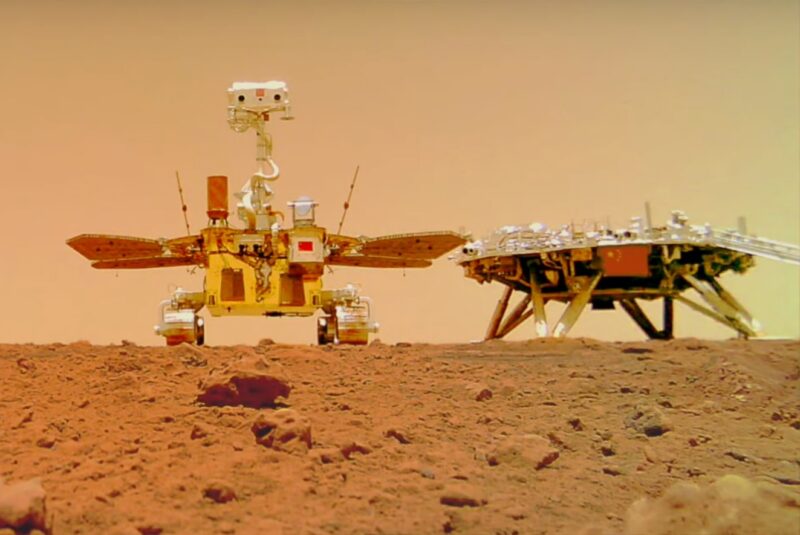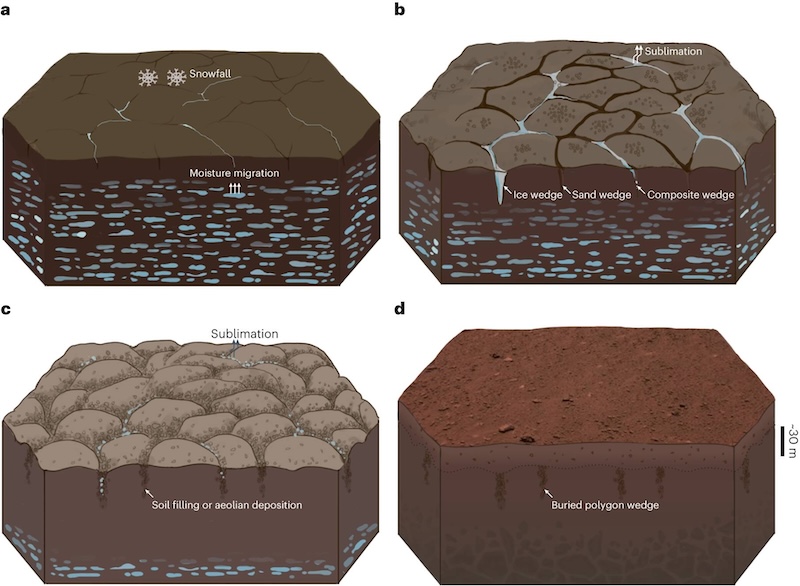
China’s Zhurong rover mission to Mars is over. But the data it sent back to Earth are still providing insights. The rover explored its landing site in Utopia Planitia, the largest impact basin on Mars, beginning in May 2021 and for 357 days (347 Mars sols) afterward. In a new paper published on November 23, 2023, Chinese researchers said that Zhurong found irregular polygon-shaped wedges – apparent clumps made of sandy Martian soil and ice, with three or more straight sides – beneath Mars’ surface. The rover used its radar to detect the geometrically shaped clumps, which are thought to be caused by freeze-thaw cycles on Mars.
Utopia Planitia, by the way, is a historic site on Mars for us earthlings. It’s where one of the first two Mars landers – NASA’s Viking 2 – set down in 1976.
The 2024 lunar calendars are here! Best Christmas gifts in the universe! Check ’em out here.

Polygons beneath Mars’ surface
Polygons beneath the surface are common on Mars. And they’re found on Earth, too. But they hadn’t been found at Utopia Planitia, until now. Space journalist Leonard David wrote about the discovery in his blog Leonard David’s INSIDE OUTER SPACE on November 24, 2023.
Lei Zhang at the CAS Engineering Laboratory for Deep Resources Equipment and Technology, Institute of Geology and Geophysics, Chinese Academy of Sciences in Beijing, China, led the research team. The researchers published their peer-reviewed findings in Nature Astronomy on November 23.
Zhurong traveled about 0.7 miles (1.2 km) during its mission. Along the route, the rover used its radar to study the subsurface. It found the polygons about 115 feet (35 meters) below the surface. David wrote:
In the just-published work, the country’s Zhurong Mars rover made use of onboard radar and detected irregular wedges (polygons) underneath its exploration zone.
The paper explained:
As the largest basin on Mars, Utopia Planitia has both experienced and recorded variations of the Martian paleoclimate. Layered subsurface structures have been identified by ground-penetrating radar in southern Utopia Planitia but lateral variations of the subsurface, potentially linked to the Martian paleoclimatic evolution, have not been investigated. Here we report the lateral frequency-variation patterns of Zhurong radar reflections and interpret them as buried polygonal terrain below a depth of 35 meters.
Altogether, Zhurong detected 16 polygons within the distance it had traveled. This suggests that the polygons are likely widespread throughout Utopia Planitia.
Freeze-thaw cycles
So, how did they form?
Zhang and his colleagues tested various possibilities through a process of elimination. Their conclusion? The researchers think that repeated cycles of freezing and thawing produced the polygons. This process has created similar features elsewhere on the planet as well. David said:
The Chinese researchers are proposing that the polygons were potentially generated by freeze-thaw cycles. That interpretation implies that there was a strong paleoclimatic variability at low-to-mid latitudes (roughly 25 degrees north), possibly due to the high obliquity of ancient Mars.
The freeze-thaw cycles may have involved water and ice and would have required an overall cold climate to occur in, the researchers said. They also would have happened when the planet was still young. The paper said that the polygons:
… might be related to water/ice freeze–thaw processes in southern Utopia Planitia on early Mars.
The water and ice may have had various possible sources, as the paper stated:
The possible presence of water and ice required for the freeze–thaw process in the wedges may have come from cryogenic suction-induced moisture migration from an underground aquifer on Mars, snowfall from the air or vapor diffusion for pore ice deposition.
The Zhurong rover mission
The Zhurong rover, part of the Tianwen-1 mission, landed in the southern part of Utopia Planitia on May 15, 2021. It had a nominal expected lifetime of 90 sols (Martian days, just slightly longer than days on Earth). The solar-powered rover had been hibernating through the harsh Martian winter, starting in May 2022. The mission team expected the rover to wake up again after that, but it never did.
China is also now looking to launch its own sample-return mission to Mars in 2028. Utopia Planitia may be the target for that mission as well, but that has not been confirmed yet.
Bottom line: China’s Zhurong rover has found polygonal wedges below the surface in Utopia Planitia on Mars. Freeze-thaw cycles of water and ice likely created the polygons.
Via Leonard David’s INSIDE OUTER SPACE











